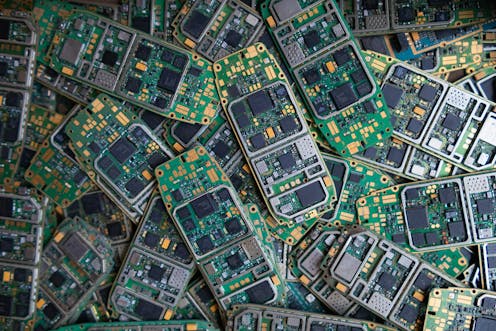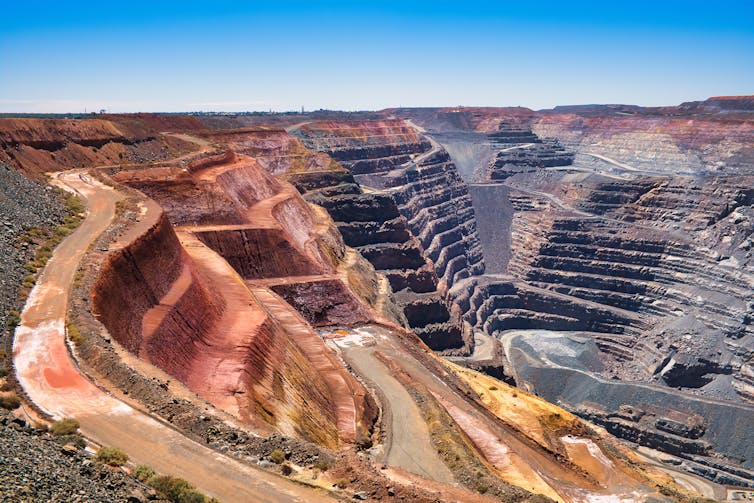
Our increasing reliance on technology is placing pressure on the global supply of materials that are essential for manufacturing electronic devices. Raw materials are being mined to cover the demand for smartphones, laptops, computer servers and electric vehicles, placing strain on the environment. A greater emphasis on renewable technology and on artificial intelligence will only add to this challenge.
But can we recover more of the materials we need for these devices from waste electronics? Improved methods to extract these metals and other elements will be key to reducing the pressure on our planet and its resources.
Some of the most important materials required for electronic devices include gold, platinum, rhodium, cobalt and lithium, as well as the 17 “rare-earth elements”, which includes materials such as neodymium and lanthanum.
All these metals are mainly used in current and emerging technology, and the demand for them is likely to outstrip supply over the next few decades. Gold is found in the printed circuit boards crucial for electronic devices, while various rare-earth metals are used in display screens and magnets.
Platinum and rhodium are vital components for the catalytic converters used in cars to reduce emissions, while lithium and cobalt are used for the batteries in smartphones, laptops and electric vehicles.
As if our tech consumption hadn’t pushed demand for these metals through the roof in recent years, COVID also helped to make it worse. The pandemic drove sales of new electronics, contributing to more waste as old equipment became obsolete. The change to work-from-home/hybrid working saw more purchases of laptops and mobile phones. People also saw the pandemic as an opportunity to upgrade their televisions and games consoles.
This has made it all the more important to recover the crucial materials we need from e-waste. One response has been from the Royal Mint, which has opened a recycling plant to recover 450kg of gold from 4,000 tonnes of e-waste per year – potentially enough for around 13 million phones. The average smartphone contains around 34mg of gold, which accounts for over 60% of the value of the metal-based parts of the phone per device.

The Royal Mint initiative is an important milestone towards adopting a greener approach to metal recovery from discarded hardware. The mint is using an ambient temperature process, which means that precious metals can be recovered at room temperatures rather than being sent to smelters. The same process also allows for the selective recovery of other metals from the waste, such as palladium, silver, copper, iron, steel and aluminium.
Toxic methods
The Royal Mint initiative is important because the recovery of technology-critical metals from recycled electronics typically employs much harsher conditions. Waste electronics generally first undergo what’s called pyrometallurgy, the extraction and purification of metals involving the application of heat in a smelter. This is done to liberate the metals from their casings.
Further purification – both for the Royal Mint and other recovery processes – is carried out using methods collectively known as hydrometallurgy. This uses water-based solutions to recover purer forms of the metal, but also produces harmful waste: strong acids, such as sulphuric acid or nitric acid, as well as a group of chemicals called lixiviants, which can include cyanides, may be used to dissolve materials.
Further treatment is required before these substances can be safely discharged back into the environment. Not doing so risks significant environmental impacts like the reported “cancer villages” in China, which some have linked to factories and polluted waterways.
Also environmentally troublesome is what’s known as artisanal, or small-scale, mining – involving individuals, groups or co-operatives, rather than corporations. This accounts for 12%-15% of the global mined gold supply, accounting for around 2,000 tonnes per year.
This mining occurs in over 70 different countries. The UN Environmental Programme estimates that artisanal and small-scale mining involve 10 to 15 million miners globally, including 4 to 5 million women and children.
The cheapest and simplest method of extracting gold from ores, as well as from waste electronics, involves using mercury. This involves boiling off the mercury, releasing toxic mercury vapour into the environment. This can significantly reduce the life expectancies of people exposed to the resulting pollution, as well as causing significant damage to local water-sources and to soil.
The opening of the metal recycling plant by the Royal Mint is therefore beneficial for various reasons besides being relatively environmentally friendly. It will lead to fewer toxic metals going to landfill that could potentially leach out into water supplies, and it will reduce our reliance on artisanal and small-scale mining for gold, reducing pollution and the risk to human health.
![]()
Chris Elgar receives funding from EPSRC grant EP/W018632/1 'Technology critical metal recycling using ultrasonics and catalytic etchants (SonoCat)'



